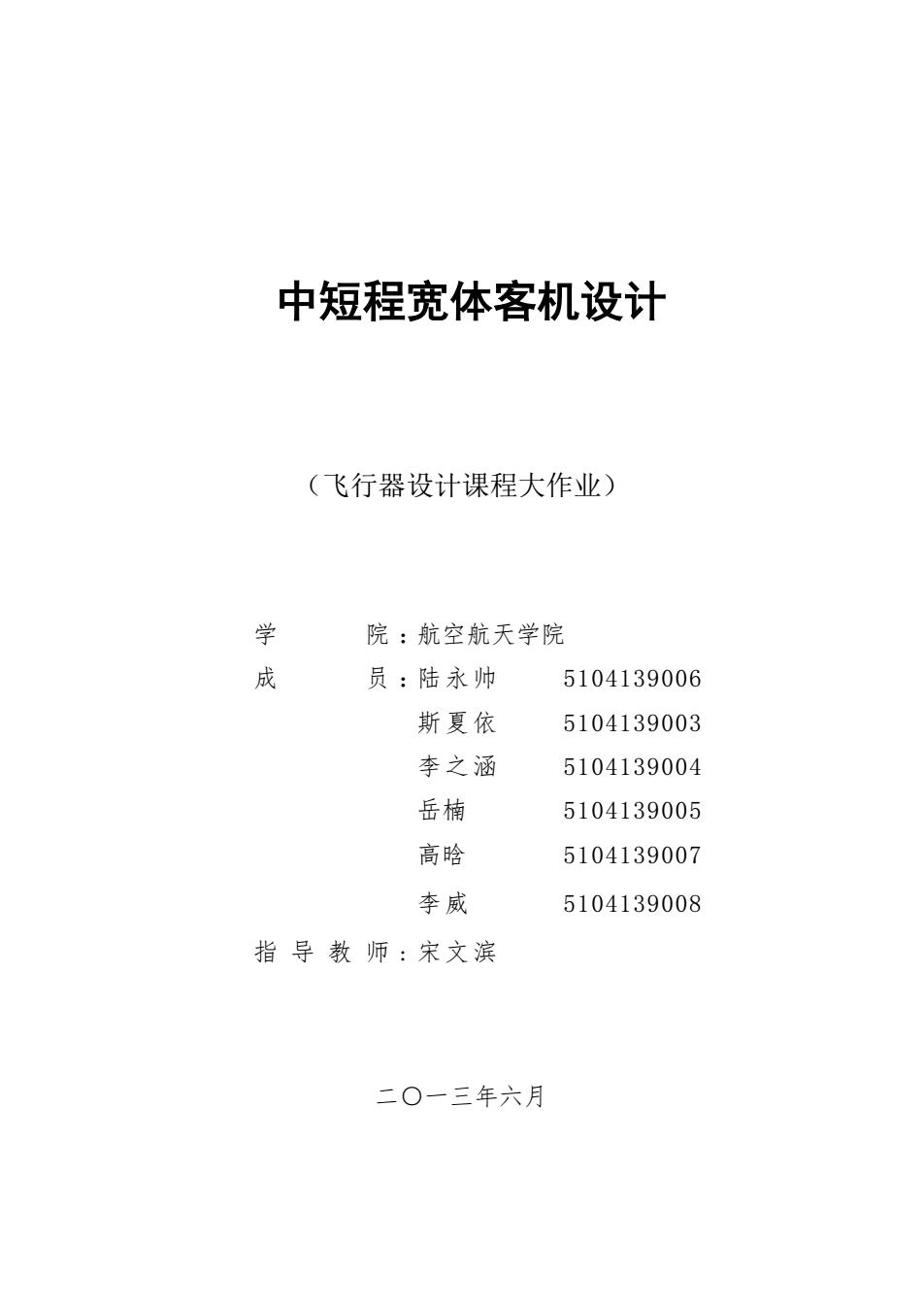
中短程宽体客机设计 (飞行器设计课程大作业) 学 院:航空航天学院 成 员:陆永帅 5104139006 斯夏依 5104139003 李之涵 5104139004 岳楠 5104139005 高晗 5104139007 李威 5104139008 指导教师:宋文滨 二O一三年六月
中短程宽体客机设计 (飞行器设计课程大作业) 学 院 :航空航天学院 成 员 :陆永帅 5104139006 斯夏依 5104139003 李之涵 5104139004 岳楠 5104139005 高晗 5104139007 李威 5104139008 指 导 教 师 : 宋文滨 二○一三年六月
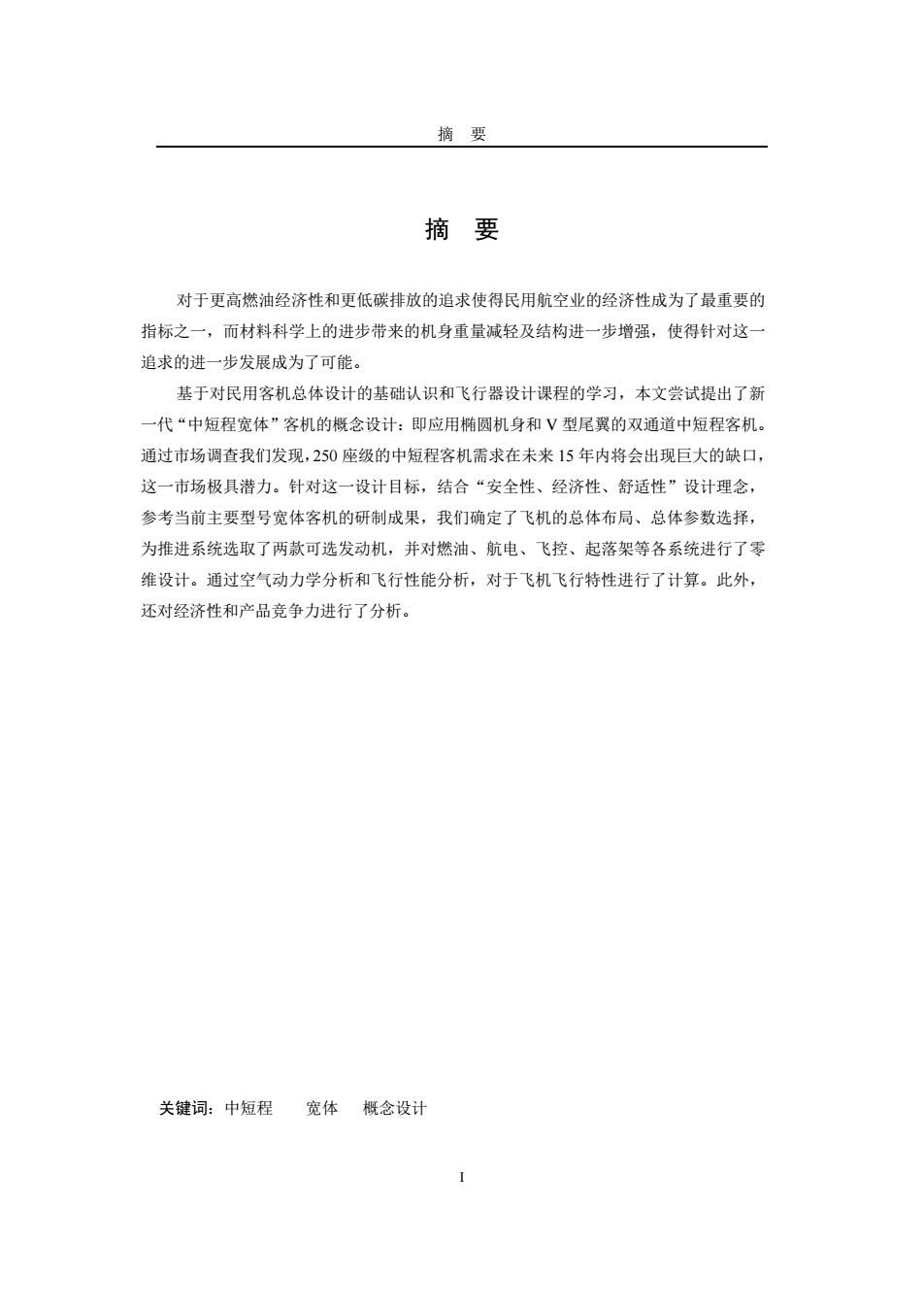
摘要 摘要 对于更高燃油经济性和更低碳排放的追求使得民用航空业的经济性成为了最重要的 指标之一,而材料科学上的进步带来的机身重量减轻及结构进一步增强,使得针对这一 追求的进一步发展成为了可能。 基于对民用客机总体设计的基础认识和飞行器设计课程的学习,本文尝试提出了新 一代“中短程宽体”客机的概念设计:即应用椭圆机身和V型尾翼的双通道中短程客机。 通过市场调查我们发现,250座级的中短程客机需求在未来15年内将会出现巨大的缺口, 这一市场极具潜力。针对这一设计目标,结合“安全性、经济性、舒适性”设计理念, 参考当前主要型号宽体客机的研制成果,我们确定了飞机的总体布局、总体参数选择, 为推进系统选取了两款可选发动机,并对燃油、航电、飞控、起落架等各系统进行了零 维设计。通过空气动力学分析和飞行性能分析,对于飞机飞行特性进行了计算。此外, 还对经济性和产品竞争力进行了分析。 关键词:中短程 宽体概念设计
摘 要 I 摘 要 对于更高燃油经济性和更低碳排放的追求使得民用航空业的经济性成为了最重要的 指标之一,而材料科学上的进步带来的机身重量减轻及结构进一步增强,使得针对这一 追求的进一步发展成为了可能。 基于对民用客机总体设计的基础认识和飞行器设计课程的学习,本文尝试提出了新 一代“中短程宽体”客机的概念设计:即应用椭圆机身和 V 型尾翼的双通道中短程客机。 通过市场调查我们发现,250 座级的中短程客机需求在未来 15 年内将会出现巨大的缺口, 这一市场极具潜力。针对这一设计目标,结合“安全性、经济性、舒适性”设计理念, 参考当前主要型号宽体客机的研制成果,我们确定了飞机的总体布局、总体参数选择, 为推进系统选取了两款可选发动机,并对燃油、航电、飞控、起落架等各系统进行了零 维设计。通过空气动力学分析和飞行性能分析,对于飞机飞行特性进行了计算。此外, 还对经济性和产品竞争力进行了分析。 关键词:中短程 宽体 概念设计
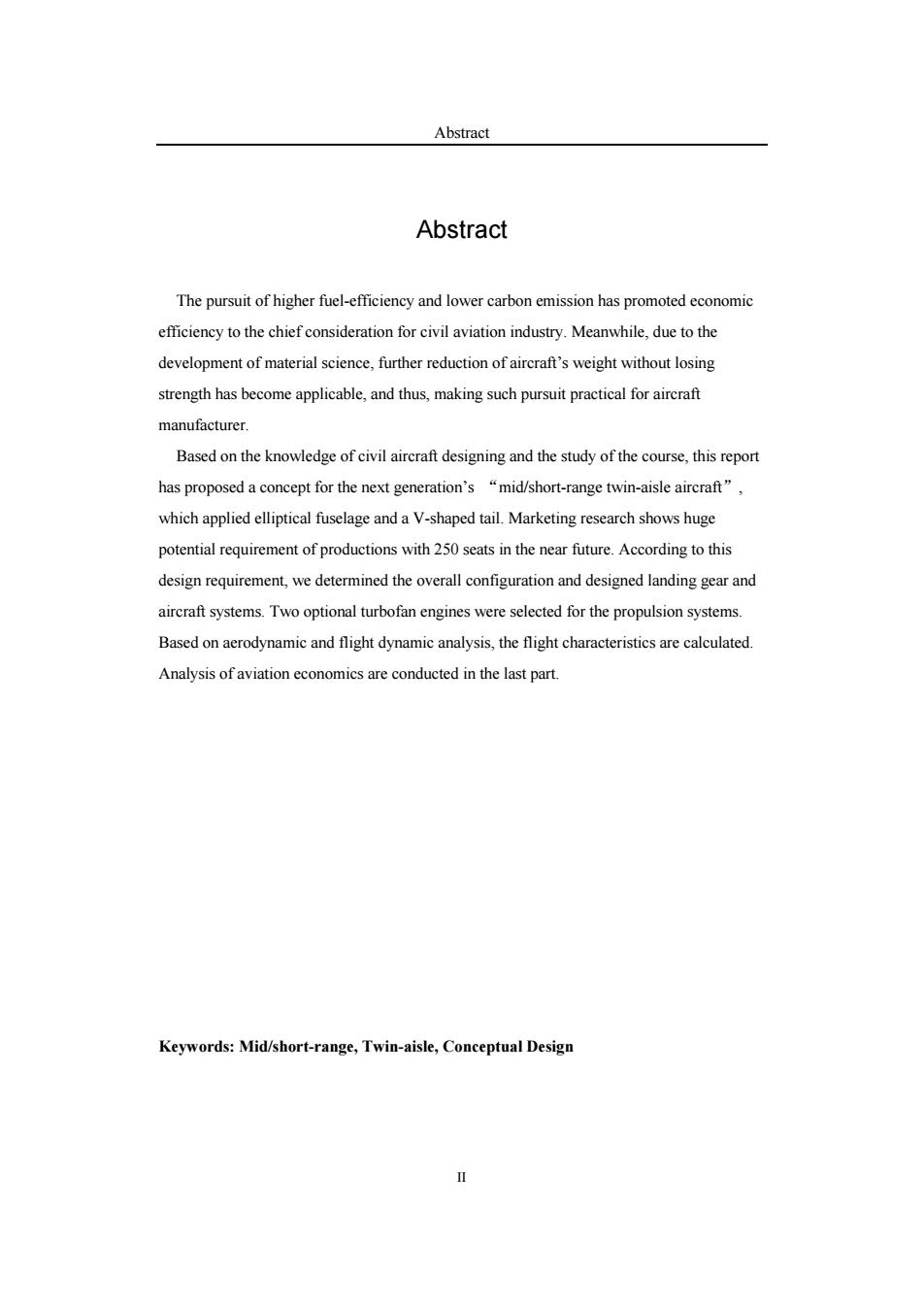
Abstract Abstract The pursuit of higher fuel-efficiency and lower carbon emission has promoted economic efficiency to the chief consideration for civil aviation industry.Meanwhile,due to the development of material science,further reduction of aircraft's weight without losing strength has become applicable,and thus,making such pursuit practical for aircraft manufacturer. Based on the knowledge of civil aircraft designing and the study of the course,this report has proposed a concept for the next generation's "mid/short-range twin-aisle aircraft" which applied elliptical fuselage and a V-shaped tail.Marketing research shows huge potential requirement of productions with 250 seats in the near future.According to this design requirement,we determined the overall configuration and designed landing gear and aircraft systems.Two optional turbofan engines were selected for the propulsion systems. Based on aerodynamic and flight dynamic analysis,the flight characteristics are calculated. Analysis of aviation economics are conducted in the last part. Keywords:Mid/short-range,Twin-aisle,Conceptual Design
Abstract II Abstract The pursuit of higher fuel-efficiency and lower carbon emission has promoted economic efficiency to the chief consideration for civil aviation industry. Meanwhile, due to the development of material science, further reduction of aircraft’s weight without losing strength has become applicable, and thus, making such pursuit practical for aircraft manufacturer. Based on the knowledge of civil aircraft designing and the study of the course, this report has proposed a concept for the next generation’s “mid/short-range twin-aisle aircraft”, which applied elliptical fuselage and a V-shaped tail. Marketing research shows huge potential requirement of productions with 250 seats in the near future. According to this design requirement, we determined the overall configuration and designed landing gear and aircraft systems. Two optional turbofan engines were selected for the propulsion systems. Based on aerodynamic and flight dynamic analysis, the flight characteristics are calculated. Analysis of aviation economics are conducted in the last part. Keywords: Mid/short-range, Twin-aisle, Conceptual Design
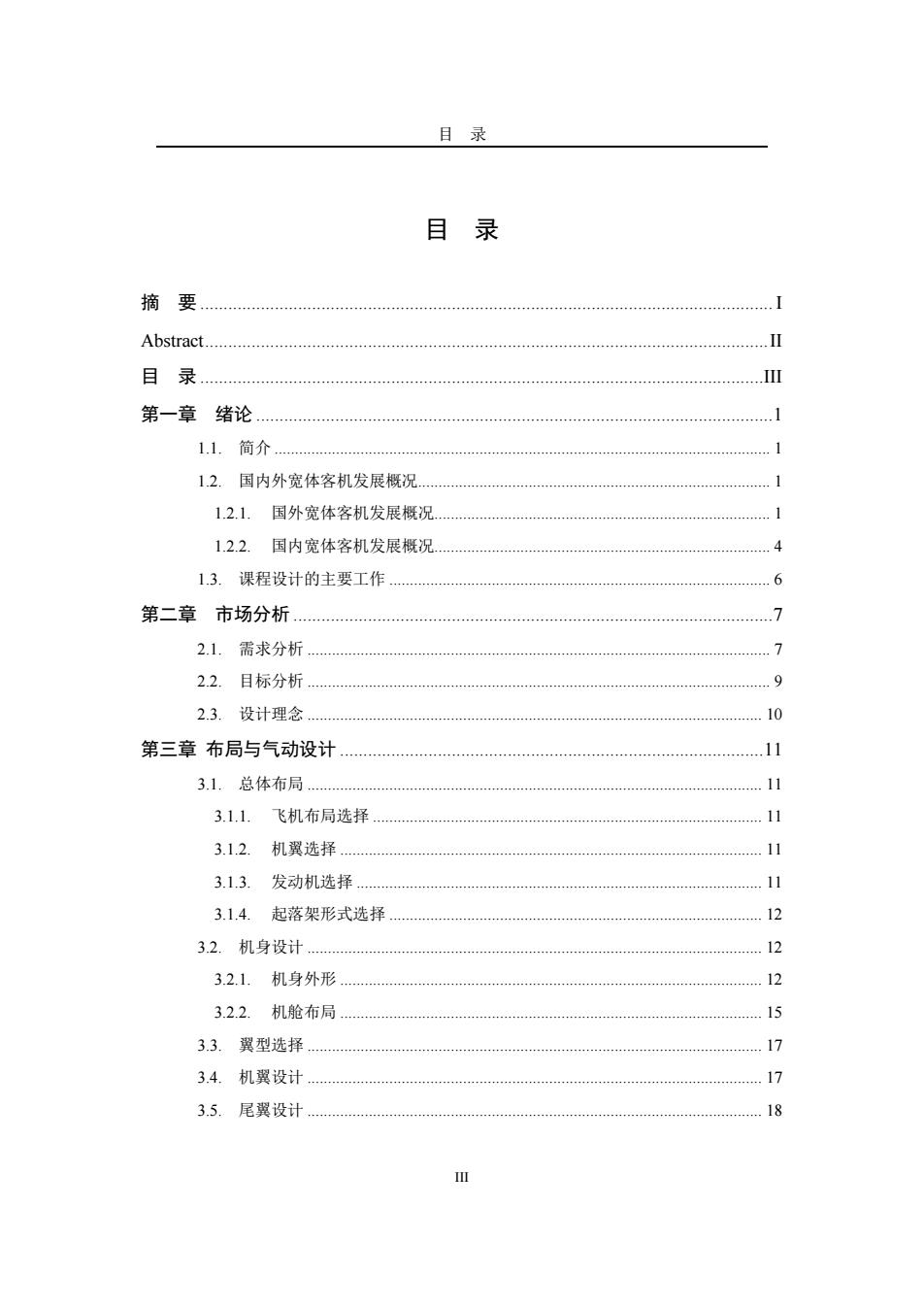
目录 目录 摘要 ..I Abstract. 目录 第一章绪论 1.1.简介 ... 1.2.国内外宽体客机发展概况 1.2.1.国外宽体客机发展概况 1.2.2.国内宽体客机发展概况 1.3.课程设计的主要工作 6 第二章市场分析 7 2.1.需求分析 2.2.目标分析 .9 2.3.设计理念 10 第三章布局与气动设计 .11 3.1.总体布局 11 3.1.1.飞机布局选择 11 3.1.2. 机翼选择 11 3.1.3. 发动机选择 11 3.1.4. 起落架形式选择 12 3.2.机身设计 12 3.2.1. 机身外形 12 3.2.2. 机舱布局 15 3.3.翼型选择 17 3.4.机翼设计 17 3.5.尾翼设计 18 Ⅲ
目 录 III 目 录 摘 要 ........................................................................................................................... I Abstract.........................................................................................................................II 目 录 .........................................................................................................................III 第一章 绪论 ...............................................................................................................1 1.1. 简介 ......................................................................................................................... 1 1.2. 国内外宽体客机发展概况...................................................................................... 1 1.2.1. 国外宽体客机发展概况.................................................................................. 1 1.2.2. 国内宽体客机发展概况.................................................................................. 4 1.3. 课程设计的主要工作 ............................................................................................. 6 第二章 市场分析 .......................................................................................................7 2.1. 需求分析 ................................................................................................................. 7 2.2. 目标分析 ................................................................................................................. 9 2.3. 设计理念 ............................................................................................................... 10 第三章 布局与气动设计 ...........................................................................................11 3.1. 总体布局 ............................................................................................................... 11 3.1.1. 飞机布局选择 ............................................................................................... 11 3.1.2. 机翼选择 ....................................................................................................... 11 3.1.3. 发动机选择 ................................................................................................... 11 3.1.4. 起落架形式选择 ........................................................................................... 12 3.2. 机身设计 ............................................................................................................... 12 3.2.1. 机身外形 ....................................................................................................... 12 3.2.2. 机舱布局 ....................................................................................................... 15 3.3. 翼型选择 ............................................................................................................... 17 3.4. 机翼设计 ............................................................................................................... 17 3.5. 尾翼设计 ............................................................................................................... 18
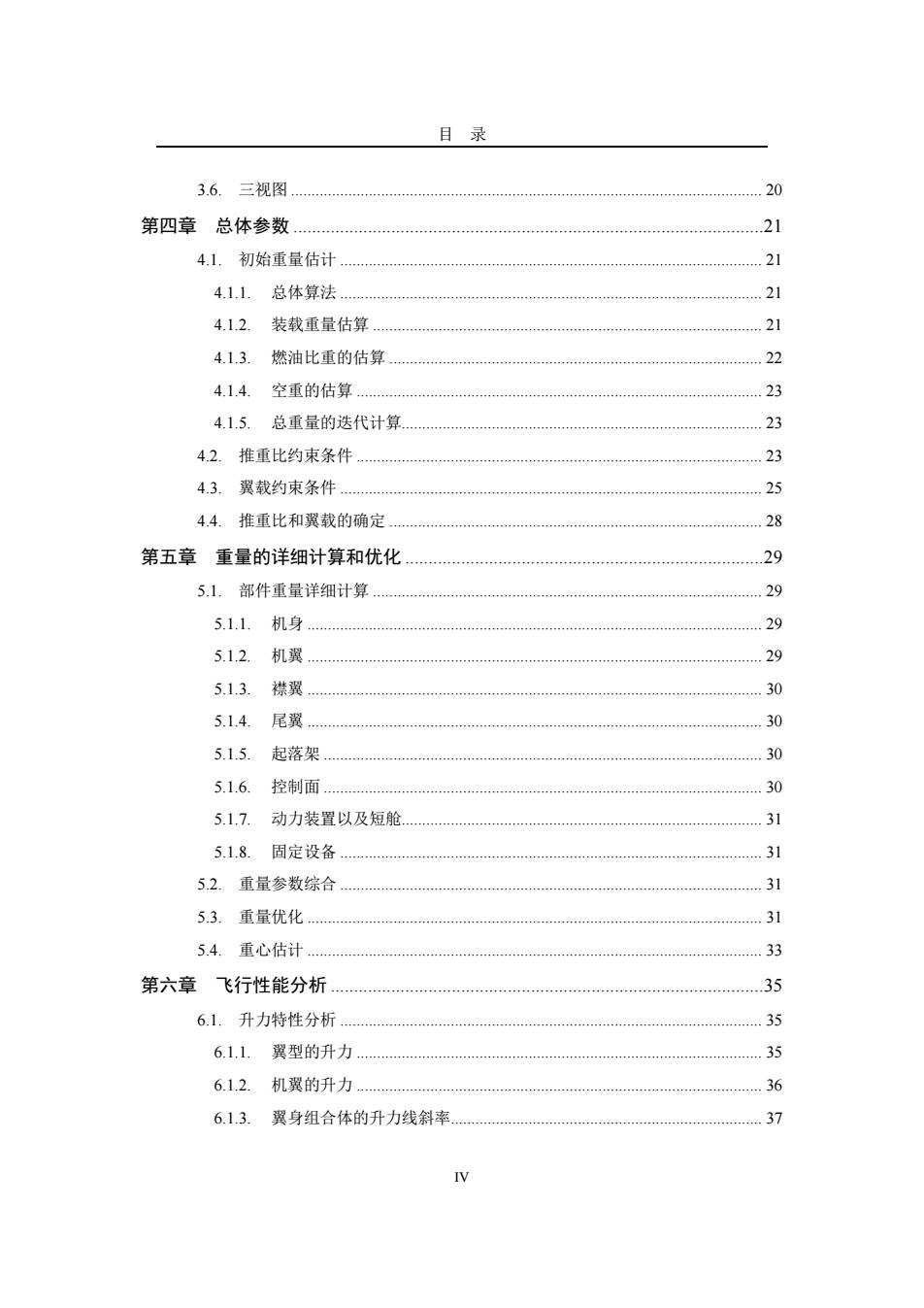
目录 3.6.三视图 20 第四章总体参数 21 4.1.初始重量估计 21 4.1.1.总体算法 21 41.2.装载重量估算 .21 4.1.3.燃油比重的估算 22 4.1.4.空重的估算 23 4.1.5.总重量的迭代计算 23 4.2.推重比约束条件 23 4.3.翼载约束条件. 25 4.4.推重比和翼载的确定 28 第五章重量的详细计算和优化 29 5.1.部件重量详细计算 29 5.1.1.机身 29 5.1.2.机翼 29 5.1.3.襟翼 30 5.1.4.尾翼 30 5.1.5.起落架 30 5.1.6.控制面 5.1.7.动力装置以及短舱 31 5.1.8.固定设备 31 5.2.重量参数综合 31 5.3.重量优化 31 54.重心估计… 33 第六章飞行性能分析… 35 6.1.升力特性分析 35 6.1.1.翼型的升力 35 6.1.2.机翼的升力 36 6.13.翼身组合体的升力线斜率 37
目 录 IV 3.6. 三视图 ................................................................................................................... 20 第四章 总体参数 .....................................................................................................21 4.1. 初始重量估计 ....................................................................................................... 21 4.1.1. 总体算法 ....................................................................................................... 21 4.1.2. 装载重量估算 ............................................................................................... 21 4.1.3. 燃油比重的估算 ........................................................................................... 22 4.1.4. 空重的估算 ................................................................................................... 23 4.1.5. 总重量的迭代计算........................................................................................ 23 4.2. 推重比约束条件 ................................................................................................... 23 4.3. 翼载约束条件 ....................................................................................................... 25 4.4. 推重比和翼载的确定 ........................................................................................... 28 第五章 重量的详细计算和优化 .............................................................................29 5.1. 部件重量详细计算 ............................................................................................... 29 5.1.1. 机身 ............................................................................................................... 29 5.1.2. 机翼 ............................................................................................................... 29 5.1.3. 襟翼 ............................................................................................................... 30 5.1.4. 尾翼 ............................................................................................................... 30 5.1.5. 起落架 ........................................................................................................... 30 5.1.6. 控制面 ........................................................................................................... 30 5.1.7. 动力装置以及短舱........................................................................................ 31 5.1.8. 固定设备 ....................................................................................................... 31 5.2. 重量参数综合 ....................................................................................................... 31 5.3. 重量优化 ............................................................................................................... 31 5.4. 重心估计 ............................................................................................................... 33 第六章 飞行性能分析 .............................................................................................35 6.1. 升力特性分析 ....................................................................................................... 35 6.1.1. 翼型的升力 ................................................................................................... 35 6.1.2. 机翼的升力 ................................................................................................... 36 6.1.3. 翼身组合体的升力线斜率............................................................................ 37